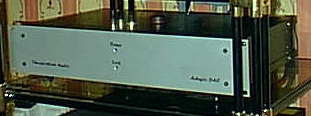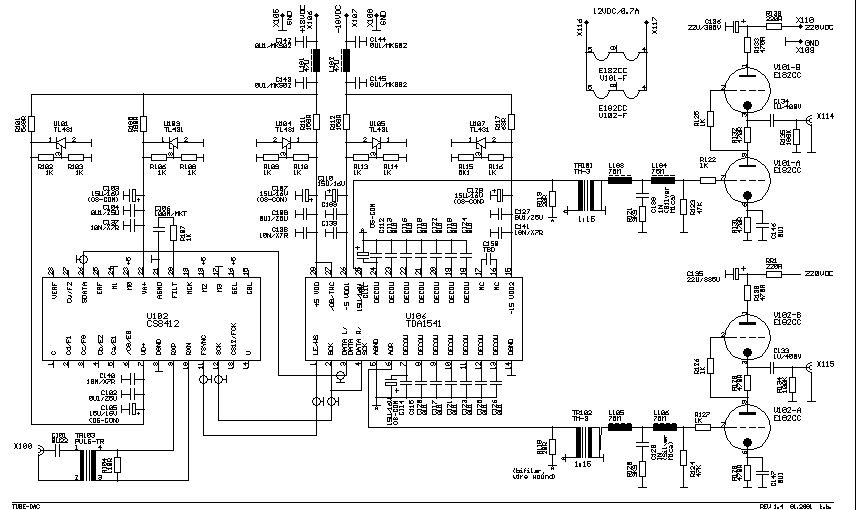
The Adagio Digital to Analog Converter

Last year during the London HiFi Show I had the chance to hear the Audio Note Japan (Kondo outside Japan) DAC. This unit, the M100 (Hibari) DAC uses no oversampling and a Valve Output Stage. The sound was absolutely outstanding. I had read about non oversampling DAC's before in MJ. I had even build a prototype of the TDA1543 based non-oversampling DAC Ryohei Kusunoki described in MJ, similar to the TNT-Convertus. This sounded quite promising but missed some refinement and sounded very nice, alive and realistic, but a little rough. I figured that ultimately the TDA1543 Chips where likely one of the limiting factors and sat down to some serious thinking.
Over years I have tried almost all the tricks in the Books to get good sound from CD. While I succeeded with modified Consumer CD-Players to match the sound of quite expensive High-End gear (such like the Audio Synthesis DAX and the Marantz CD7); I always felt that something was "not right" with the sound of CD. I tried various DIY and commercial DAC's finding nothing that really exceeded the best possible from modified inexpensive CD Players. As a result I practically never bought CD's and used Vinyl pretty much exclusively.
I will not specifically discuss the background of non-oversampling, this has already been done by Ryohei Kusunoki in great detail and with excellent understandability. I would perhaps also add that the non-oversampling DAC releases comparably large quantity of digital images, which will act as signal depended ultrasonic dither(1). In addition these images provide some measure of ultrasonic output that is again closely signal related and may hence contribute to a subjectively better sound to be perceived(2). In fact, similar behaviour is simulated with certain Digital Filters, specifically the Pioneer Legatolink® Filter, which I have subjectively always preferred to other options. Enough of technical background though.
Clearly the Hibari DAC had shown me just how good the non-oversampling DAC concept could be. I definitely wanted some of this sound, in fact I wanted as much as I could get. I decided that a better DAC Chip was needed for starters. Kondo San uses 16 pcs of a specific Burr Brown chip in parallel. For a while I considered a similar approach using 16pcs of TDA1543. Other options considered and tested where the Burr Brown PCM-63.
In the end I settled on the classic Philips TDA-1541 DAC chip for my own use. The TDA1541 is actually specified for both non-oversampling and 4 times oversampling applications. The Data for the non-oversampling operation showed a performance close to the theoretical limits for 16-Bit Digital Audio. I found this data in old Datasheets kindly given to me by Chris Found. Discussing the subject further Chris Found commented upon a number of measures that can be taken to improve the sound of the TDA1541. Interfacing the TDA1541 with a Digital Receiver is easy too; no glue logic is needed unlike with other chips.
For the digital receiver I settled upon the Crystal CS8412 in the latest revision. While by now outdated this Chip was well known to me and I had experience in obtaining the best performance from it. Key factors where thus decided for a CS8412 feeding directly a TDA1541 (double Crown). All that remained was to consider the Powersupply arrangements for the Digital circuitry and the analogue stage circuit. The Digital supply was easy, both myself and a number of others have found individual shuntregulators per pin, based around the TL431/LM431 with suitable local decoupling work best.
After much deliberation I decided to play "safe" for the analogue stage and mostly copied the Circuit Audionote UK used in their DAC4 Signature (older, oversampling Model). I changed a number of parts values and redesigned the passive filter to suit the different applications, otherwise most of the Circuit designed by Audionote UK was left alone. I knew the DAC 4 Signature from experience and considered it's analogue stage to be pretty good, so why change a winning formula? You can get the DAC 4 Signature Schematic from Audionote UK, this also shows some of the circuit details currently not covered here.
The full circuit for DAC and analogue stage is shown below.

All the decoupling Capacitors on the TDA1541 (marked as 0U1) should be Foil & Film Polypropylen or better (no PIO please). On the MSB additionally a Sanyo Os-Con is used.
The PSU for the Valve Stage is with a 240V Mains Isolation Transformer, and 6X4 Rectifier combined with two superfast softswitching Telefunken Diodes in a hybrid Bridge rectifier. I find this to sound identical to a pure valve rectifier. Additional windings for heaters (6.3V for the Rectifier and 12.6V for the analogue stage heaters) and the DAC PSU (22V - 0 - 22V) where wound on by hand.
The HT Supply Circuit is shown below (rectifier part inaccurate):

The Capacitors are sections of a Nichicon Multisection Cap (40+40+200uF/385V). The analogue stage Heaters are lifted up via 220k-100k and are 12V DC. The "raw" supplies for DAC and Receiver should be +/- 18V. In my case these are Regulated via LM317/337 and schottky rectified 22V - 0 - 22V with 2,200uF/35V Rubicon XYB Series Capacitors and LC Filtered with another pair of 2,200uF/35V Rubicon's and some chokes I had at hand.
In the analogue stage the LC lowpass filter is tuned accurately with the inclusion of parasitic components and the non-ideal behaviour of the interstage transformer to offer minimal rolloff at 20kHz. It also compensates for the sin(x)/(x) HF roll-off (around 3db @ 20kHz) caused by the staircase nature of the DAC's output current. The interstage transformer is Amplimo TM-3, other units will require the filter to be re-tuned. The 20 Ohm resistor is a hand build bifilar wirewound made with copperwire for better sound. Both Transformer and filter chokes are magnetically shielded.
The resistors in the analogue stage are also entirely my usual NOS noninductive, nonmagnetic wirewound resistors. The Output coupling capacitor is very high in Value, to allow use with low impedance passive volume controls. I used a heavily bypassed Anasar supersound unit here. A second "high impedance" output uses a ERO KP1832 0.52uF/250V Foil & Film Capacitor for better sound if the load is above 100k.
How does it sound? Better than I expected and I expected a lot. The best sign is perhaps that I'm now regularly buy CD's and listen to them. The sound is open, warm and natural, very unlike digital audio in fact.
Below some more Pictures:
Top view of the DAC showing general layout
Inside view of the DAC showing the Valve Circuitry in detail
References:
1. Douglas Rife, DRA Labs, in a Letter to Stereophile "Ultrasonic spectra and better sound quality"
2. T. Oohashi et al, "High-Frequency Sound Above the Audible Range Affects Brain Electric Activity," AES Preprint No.3207 91st Convention, New York